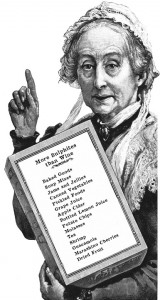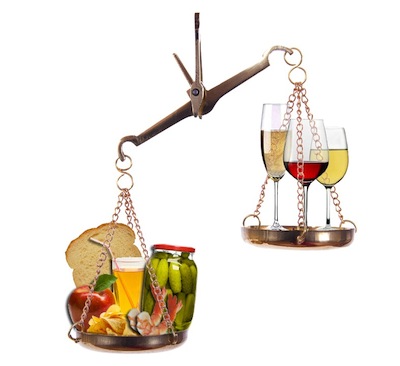The TRUTH about Sulfites in wine

Let’s start with the facts, then go into the details.
Fact #1: If you get headaches from wine, it is most likely not because of the sulfites.
Fact #2: Sulfites are a natural and essential ingredient for wine stabilization. To repeat: natural and essential.
Fact #3: European wines contain the same amount of sulfites as those in America. It’s simply our labeling laws that lead to confusion.
***
The start of the sulfite issue
Remember the salad bar craze of the 1980’s? No restaurant, no matter how fancy, could resist the idea of having a fifty yard long selection of greens, fruits, nuts, dressings, and bacon bits. All day long, everyday, customers would be told “and you can help yourself to the salad bar anytime.” Riots ensued as frantic customers rushed for the romaine, stomping the elderly on their quest for the bleu cheese dressing. Ok, maybe not riots, but salad bars were a big deal.
Which lead to a problem: how do you keep spinach that is sitting out untouched for eight days at a time (spinach was not very popular in the Reagan years) from wilting? How do you keep those apples looking fresh between lunch and dinner?
Enter the overuse of sulfites.
To keep those veggies and fruits looking good, restaurants used ungodly amounts of sulfites, effectively blocking any and all oxygen from contacting the product. With early Madonna or Duran Duran playing through the speakers, cooks would walk up and down the salad bar with spray can in hand, dousing the product.
Keep in mind that sulfites are natural (more on that later), and keep in mind that the low levels of sulfites we are continuously exposed to pose no danger to 99.99999999% of the population (okay, that stat is made us … let’s instead say “incredible vast majority”). However, asthmatics as a group have more sensitivity to sulfites than others, and it was asthmatics as a group that started dropping like flies next to the salad troughs across America. (okay, maybe ‘dropping like flies’ is a wrong term … but there were 13 deaths associated with salad bars during this time). The insanely high and extremely dangerous levels of sulfite being used to keep the broccoli looking good did these poor souls in.
Enter the Federal Government! They will save the day! We can’t have this craziness happen across our land! This is America! So rather than listen to scientists, or work with the restaurant associations, or simply put out a flyer warning of sulfite reactions, they attacked the wine industry.
Sulfites are natural, and American labeling laws
Even as long as 500 years ago the formulas for using sulfites for preservation in wine were well-known, including German texts that encouraged the burning of powdered sulphur, wood shavings, and herbal concoctions into a barrel to help infuse the wine with sulfites. Oxygen is the enemy of wine, and before the advent of stainless steel tanks it was always a battle to keep the O2 at bay. Yes, in the mid 20th century sulfites were used a bit more than they should have been, but as our understanding of chemistry heightened, less and less sulfite was needed.
Fast forward to the 1980’s. We enjoyed our neon clothes and rocked out to “The Safety Dance”, our salad bars were long and delicious, and we enjoyed both American and European wines. In 1987, the passage of the new Federal Wine Labeling Law took effect and gave all wineries selling their product in the United States one year to comply: you must label all wines containing at least 10 ppm sulfite as “Contains Sulfites.”
Want to learn how screwed up this law is? A totally natural level of sulfites, produced as a by-product of a natural fermentation (I intentionally use the word ‘natural’ twice) is 10-20 ppm. Most wine makers will add a small amount more, bringing the level to an industry average of 125 ppm. This is still far below the threshold of danger, and ironically the following food items will often contain higher levels of sulfite without the labeling law applying to them:
Baked Goods
Soup Mixes
Jams and Jellies
Canned Vegetables
Pickled Foods
Grape Juice
Apple Cider
Bottled Lemon Juice
Potato Chips
Molasses
Tea
Shrimp
Guacamole
Maraschino Cherries
Thus, wine was singled out in a very strange way.
So how did the law impact public perception? In 1988 the law was in full effect, and rather than educate consumers or open discussion the opposite occurred: because there were suddenly wines on the shelf that said “Contains Sulfites” next to ones that didn’t (from previous vintages), the new wines were stigmatized. Compounding the issue was the increased European travel that many Americans began to enjoy. Sitting in a cafe in Paris or at an enoteca in Tuscany, they turned the bottle around and exclaimed “Honey! Look! They don’t use sulfites in Europe!”
Oh, but it gets even more convoluted. Enter the term “organic wine” and there is a whole new spin to this craziness. To use the term “organic wine” (as opposed to the more common “grown with organic grapes”) on a wine label in the United States, a wine can have no added sulfites and must be below 10ppm. Yes, sulfites are natural. Sulfites occur spontaneously Sulfites are found in many of the foods we eat, at levels far higher than 10ppm. Sulfite levels in many organic foods are far higher than 10ppm but wine has been targeted as the evil that must be regulated. Does this make sense to you? It doesn’t to us either.
Sulfites are not to blame
So what is causing the occasion ‘wine headache’ with some people? The truth is we don’t know, but don’t blame the sulfites. Because of the widespread presence of sulfites in many things we eat, you can rest assured sulfites are not a problem. (And if you are one of the rare folks that do have a sulfite allergy, you know it and your diet is restricted because of it.)
If you do suffer from headaches, it might be a histamine reaction. Try taking an anti-histamine before the next big wine tasting and see if it helps.
Sadly, there is no money to study the subject of wine and headaches. As Andrew Waterhouse of the Waterhouse Lab at the University of California, Davis, says:
There is no medical research data showing that sulfites cause headaches! There is something in red wine that causes headaches, but the cause has not yet been discovered. Refer to the Bakalinsky article above. To avoid these common headaches, try drinking less wine, and drink with food. If you think sulfites are causing your headache, try eating some orange-colored dried apricots, and let me know if that induces a headache. If not, sulfites are not the likely culprit. These bright colored dried fruits typically have 2000 mg/kg sulfites, so a two ounce serving (56 gm) should contain about 112 mg sulfites. It is certainly possible that sulfites cause headaches, but as noted above, there is no data available. Feel free to send a memo to the NIH suggesting this be the target of future research so the question can be addressed.
We hope this article has opened your eyes and brought more understanding to this subject. Further information can be found of the following fine websites.
About.com on Wine Sulfites
Sulfites in wine: the myths, the facts, and the truth on thekitchn.com
Waterhouse Lab, UC Davis, paper on wine sulfites
Palate Press: Much ado about sulfites, French wines, and organic regulations








